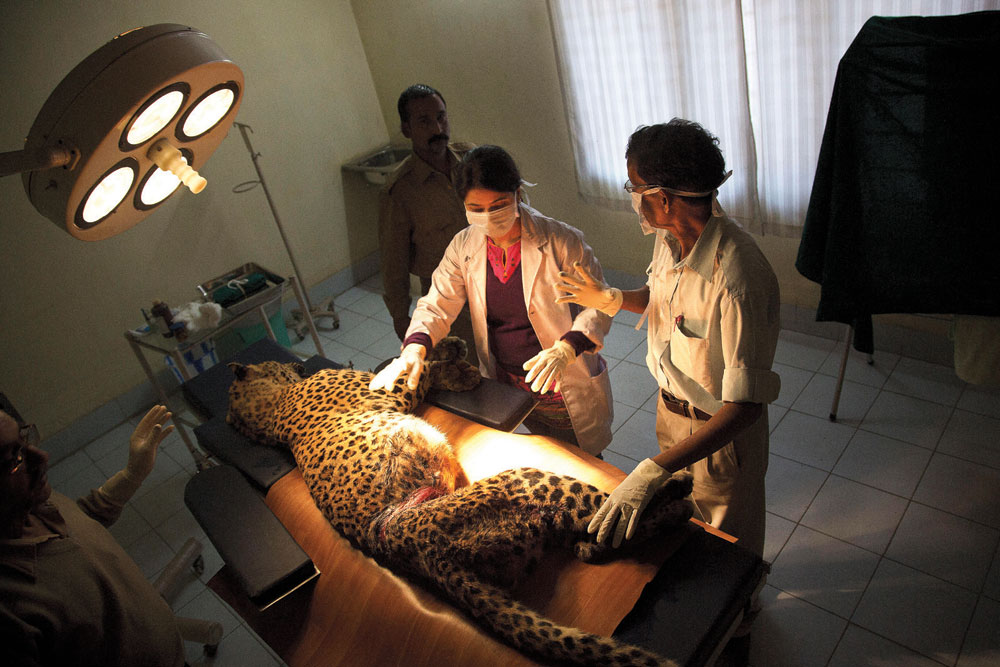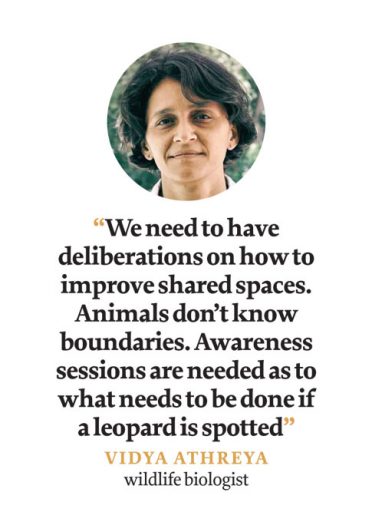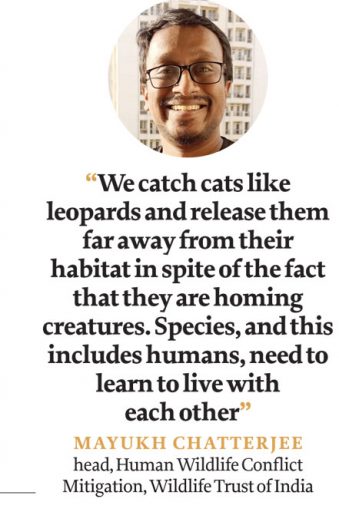How Many Leopards Does India Have?
Till we can answer that there is no good estimate of how many have been killed
 Nikita Doval
Nikita Doval
 Nikita Doval
Nikita Doval
 |
06 Nov, 2020
|
06 Nov, 2020
/wp-content/uploads/2020/11/Countingthespot1.jpg)
A wild leopard in Dudhwa Tiger Reserve, Uttar Pradesh, March 2017 (Photo: Getty Images)
The findings of a new leopard census will be released this month, once again drawing the spotlight on the cat in the man-animal conflict debate.
In the autumn of 2018, Ankush Muneshwar, then Sarpanch of Wedshi village in Yavatmal, Maharashtra, was a very worried man. A cow-herder from his village Gulab was widely suspected to have been killed by a rogue tiger and similar reports were coming in from other villages in the area. It was reaping time and villagers, instead of spending their time in the fields, were cooped inside, leading to concerns about financial ruin. The man-eating tiger, T-1, who was briefly more famous as Avni, was eventually shot dead in November 2018 by a private hunter and even though Muneshwar was elated, he was also concerned, “Waghoba was angry with us. We need to appease him.”
Muneshwar was referring to a large cat deity, deriving its name from the Marathi ‘wagh’, for big cat. Waghoba temples dot the landscape in not just Maharashtra but also Goa. There is one in Mumbai’s Aarey Milk Colony also. Some of these temples, mostly no bigger than a shrine, are believed to be at least a few hundred years old. The deity, villagers believe, protects them from the dangers of the forest, namely the big beasts, both tigers and leopards, living in them. Wildlife experts tell us that the presence of the deity, be it Waghoba in western India or Dakshin Rai, the god of the Sunderbans, points to a long tradition of man and beast sharing space and co-existing, not always peacefully but respectfully nonetheless. The deity, at least in western India, represents not just the tiger alone but also the leopard. Smaller, more agile and more elusive, the leopard has long lived on the natural borders between forests and human settlements, unlike the tiger which dislikes humans.
But it is only in recent years that the leopard finds itself making news almost every other day: for killing people, being captured in housing localities, dying while crossing highways or being lynched—not the treatment one would expect to be meted out to a deity or its living manifestation. Be it Mumbai or the Gurgaon-Faridabad highway or Greater Noida housing complexes, leopard sightings have been rising. According to the Wildlife Protection Society of India’s (WPSI) estimate, while 460 leopards died in 2018, the figure rose to 490 in 2019. In 2020 so far, 358 leopards are believed to have died. But, experts say, these numbers are just indicative, representing the deaths that were detected. Tracking leopard deaths is tricky; we only extrapolate from those detected.
The first leopard census in India, conducted in 2014 (but as part of the tiger census), had thrown up a figure of 7,910 (not including the Northeast) and only in protected forests. Since leopards also live outside protected reserves, an estimate of 12,000-14,000 was made. Critics have questioned this number given the diverse nature of the cat’s habitats. The Wildlife Institute of India (WII), which conducts the tiger survey, is set to release a census of leopards in November, according to Qamar Qureshi, senior scientist at the WII. “The population has been mapped in forested areas and rounded off to a conservative estimate,” he tells Open. Currently, the leopard is classified for the highest protection under the Wildlife Protection Act, 1972.
12,000-14,000 leopards were estimated to be in India after the first census in 2014. Critics have questioned this number given the diverse nature of the cat’s habitats
Leopards, wildlife experts say, have always lived close to humans, be it in rural areas or even cities such as Mumbai and Nairobi without people realising so. They can live off smaller prey such as chickens, dogs and even rodents. “Leopards are extremely adaptable. And over many centuries they have also adapted themselves to human beings. They can live beside you like your shadow and you won’t even know they are there. They can detect you before you detect them and will try and avoid you; unlike tigers they do not stand their ground. It is only now that this adaptability in a leopard is being perceived as detrimental, it has led to panic, lynchings have gone up, there is growing resentment,” says Mayukh Chatterjee, Head, Human Conflict Mitigation Division, Wildlife Trust of India (WTI). Instances of leopards killing children and sometimes even adults have been on the rise though experts say these are usually last-ditch resorts for leopards that prefer other prey.
Vidya Athreya, wildlife biologist and one of India’s leading experts on leopards, does not like the use of the word ‘conflict’ with regards to man-animal interaction and says that urban elites don’t often understand the acceptance and tolerance that exists in rural areas because of shared spaces. “We need to have deliberations on how to improve shared spaces,” says Athreya. This would mean including a whole range of stakeholders right from the locals, forest department and even the media. “Animals don’t know boundaries. Awareness sessions are needed as to what needs to be done if a leopard is spotted,” she says. Before 2011, Athreya says, the forest department in Maharashtra did not entertain any one. It was around this time that leopard attacks on humans were increasing across the state. Apart from understanding the reasons behind this behaviour, the state forest department organised workshops jointly with experts to increase the understanding of laypeople. “The media also became an important stakeholder as repeated news reports helped draw attention to the issues at stake.” Athreya is specifically referring to the Sanjay Gandhi National Park which is believed to have at least 40 leopards, thus making densely populated Mumbai also the city with the highest density of leopards in India. As housing colonies started coming up near the park in the 2000s, leopard sightings caused panic, leading to pressure from the public, politicians and even the media. It was Athreya’s work in the Junnar region that led to the realisation that the forest department’s drive to capture leopards from farmlands and releasing them in forests abutting human settlements were leading to attacks. Leopards are territorial and when relocated to an area where other leopards already exist, they will move closer to human settlements where conflict is always a possibility. These findings along with community engagement and a pro-active response from the departments concerned went a long way in making co-existence possible. In Mumbai’s Aarey Milk Colony, humans and leopards have now been learning to live with each other with more than moderate success, although stray incidents still occur.

The colonial approach to wildlife in India was first decimation and eventually conservation in the 19th century, keeping the interests of Empire in mind. Even today, wildlife conservation policies in India are corrupted by the ‘managing wildlife’ lens. “Wildlife needs to be co-existed with, not managed. We catch cats like leopards and release them far away from their habitat in spite of the fact that they are homing creatures. Species, and this includes humans, need to learn to live with each other,” says WTI’s Chatterjee. He cites the example of the Pilibhit tiger reserve which is also home to a huge leopard population and where humans and the cats co-exist though not always peacefully. Last year, a tigress was beaten to death by villagers after she attacked people working in the fields. A 2018 report published by the Uttar Pradesh forest department and the WTI analysed the pattern of attacks on humans and sought to identify the underlying factors. Most of the attacks had taken place during daytime, lending credence to the belief that the attacking tigers were startled or disturbed by villagers foraging in the forest. Leopard attacks, particularly on children, took place when the children were either defecating or sleeping. A few modifications or precautions on the part of humans—such as not entering forests alone, leaving children unattended and even stopping defecating in the open—could help reduce the attacks, the report suggested. “The drive is to look for push-button solutions be it elephants, tigers or leopards. But there is no one solution—it is a process. Conflict is a result of development over years, it requires resolution at the community level,” says Chatterjee who was involved with the report. Focus also needs to be on modified landscapes, such as tea gardens, even sugarcane fields, habitats that can afford sufficient cover to leopards but still ensure easy access to prey.
596 leopards were killed in 2015-2019 for wildlife trade and poaching, with Uttarakhand and Maharashtra reporting the highest number of incidents
Even when the cats steer clear of humans, there can be conflict if livestock are under threat, especially for small farmers. Fencing of farms or even livestock pens, in an inexpensive manner, is easily achievable, but there is a lack of both initiative and interest. “There is a shift of responsibility that has taken place, from the farm owner to the government. There seems to be an assumption that animals are now state objects and the havoc wreaked by them has to be compensated for by the government, which is very disheartening,” says a community sensitisation expert who did not wish to be named. In urban areas this responsibility translates into ensuring there are no garbage dumps as these would attract pigs and dogs which in turn would attract leopards.

here is another danger that the Indian leopard faces, made even more lethal by the fact that we don’t have the exact numbers for the population: poaching. According to the WPSI, 129 leopards were killed in India in 2019 by poachers, but experts say this is just the tip of the iceberg. Earlier this year, Traffic, an international NGO that works on trade in wild animals, released a report stating that between 2015 and 2019, deaths of 596 leopards in India were linked to wildlife trade and poaching, with Uttarakhand and Maharashtra reporting the highest number of incidents. The skin of a leopard remains the most in demand, followed by its claws, teeth and bones.
“There is a distinct possibility that leopard bones are passed off as tiger bones given the huge demand there is for those. It is rather worrying because we don’t have an exact number for leopards and as such it is tough to keep track of just how many of the cats we are losing. Right now I would hazard a guess and say that we are losing more leopards than tigers everyday,” says Anish Andheria, President, Wildlife Conservation Trust. Leopard deaths due to road and train accidents also remain a large concern. In 2019, more than 80 leopards were killed in road and train accidents, the most in a decade. With more roads being laid, experts fear this number will only go up.

Some experts argue that with the bulk of attention, and not to mention resources, focused on tigers and then elephants, other wildlife in the country have suffered. WII’s Qureshi however begs to differ. “Tiger conservation has helped other wildlife in ways unimaginable.” In quality habitats, such as protected forest areas and reserves, leopards can co-exist with tigers as understood from the census. But socially, culturally and historically, it is the tiger that gets public attention in the country. “We are very fortunate that we have three big cats in the country; lions, tigers and leopards. The lion, even in other cultures, has always been the most revered. Only kings were allowed to hunt tigers because the beasts, due to their sheer size and magnificence, commanded a certain stature. The leopard is powerful too but not on the same scale though it is more wily. Society has created more stories, more legends about the other two cats,” says Qureshi.
Many of the concerns about leopards today have existed for tigers too. However, leopards are more vulnerable as they find living closer to humans easier even as ever expanding human habitats move closer to them. And while there is respect tinged with fear, as evident from the Waghoba shrines, leopard conservation in India will also require communities to engage and step back to move forward.

/wp-content/uploads/2025/05/Cover-War-Shock-1.jpg)












More Columns
A Trump Shock To The Pharma World Open
Social Media As an Echo Chamber Nandini Nair
Seventy-two Hours That Changed South Asia VK Shashikumar